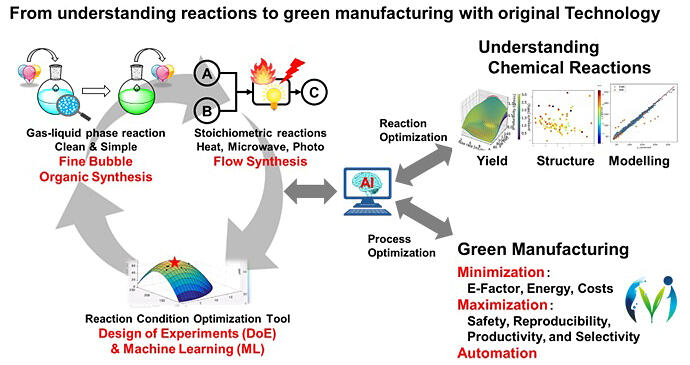Fairy chemicals discovered at Shizuoka University have been shown to increase crop yields by improving plant tolerance to biotic and abiotic stresses, and their social implementation is expected to significantly contribute to sustainable agriculture. However, the synthesis of fairy chemicals was limited to laboratory-scale research because it required many steps and long reaction times, and the use of highly toxic substances such as cyanide fume was inevitable.
A research group led by Professor Nobuyuki Mase of the Research Institute of Green Science and Technology at Shizuoka University has successfully developed a strategic green manufacturing synthesis method for the industrial production of fairy chemicals discovered by Professor Hirokazu Kawagishi (currently Professor Emeritus) and his colleagues. The research group introduced fine bubble technology that they developed themselves for short-step synthesis and the simplified after-treatment to form the imidazole skeleton through rapid one-pot hydrogenation and intermolecular cyclization. They also succeeded in the solid-state isolation of 4-diazo-4H-imidazole-5-carboxamide (DICA), an intermediate previously considered unstable, facilitating the purification of the intermediate by crystallization. Furthermore, they used catalytic amounts of iodine-based reagents to convert DICA to a fairy chemical via intramolecular cyclization in just 13 minutes.

Provided by Shizuoka University
With their method, 2-azahypoxanthine (AHX), a fairy chemical, could be synthesized from an available starting material through fewer synthetic steps, with a significantly increased yield (overall yield of 47%) and a shorter synthesis time. As no highly toxic substances are used, this new synthetic method is expected to open a path to the practical application of fairy chemicals.
Mase said, "We started this research in 2017. When I learned that fairy chemicals discovered at Shizuoka University had the potential as new plant hormones, I, as a member of the Faculty of Engineering, started to think about their industrial production based on green manufacturing. I have struggled to repeat trial and error day after day with a small group of ambitious and hard-working students, keeping in mind the incorporation of our original technology (fine bubble-based organic synthesis) as an absolute prerequisite."
"Then, Arun from the Indian Institute of Technology Hyderabad entered Shizuoka University's doctoral program 2 years ago and worked on this research to publish these results as a paper. Although we have not yet reached a method for industrial production, we dream of contributing to the world with synthetic methods constructed in Shizuoka to produce compounds discovered in Shizuoka. Join us in contributing to the world with our comprehensive knowledge of natural product chemistry, organic chemistry, and process chemistry."
Shizuoka University: https://www.shizuoka.ac.jp/english/
Shizuoka University Research Institute of Green Science Technology: https://www.green.shizuoka.ac.jp/en/
Professor Nobuyuki Mase's Lab: https://linktr.ee/mase.nobuyuki
Journal Information
Publication: Organic & Biomolecular Chemistry
Title: Fine bubble technology for the green synthesis of fairy chemicals†
DOI: 10.1039/D4OB00237G
This article has been translated by JST with permission from The Science News Ltd. (https://sci-news.co.jp/). Unauthorized reproduction of the article and photographs is prohibited.




